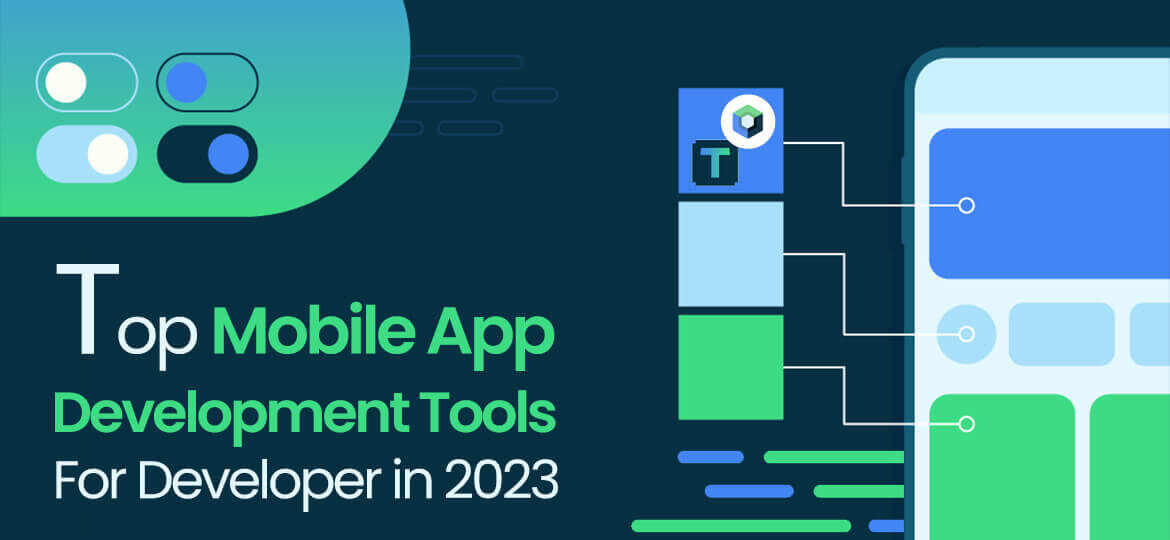Choosing the right mobile app development tools is essential to building high-performing, scalable, and user-friendly applications. With the rapid evolution of mobile application development, developers today need flexible and feature-rich tools that support various operating systems, development environments, and deployment platforms like the Apple App Store and Google Play.
Whether you’re creating native apps, cross platform apps, hybrid apps, or web apps, this curated list of top 10 tools covers everything from coding, UI/UX, testing, backend, and publishing — helping you master the full app development process.
1. Android Studio
The official IDE for Android app development, Android Studio is a powerful application development tool built on IntelliJ IDEA. It supports Java, Kotlin, and C++, offers built-in emulators, visual layout editors, and seamless deployment to mobile devices via the Google Play store.
2. Xcode
For iOS app developers, Xcode is Apple’s official IDE that supports Swift and Objective‑C. It offers integrated design, coding, testing, and debugging for building robust native apps for the Apple App Store.
3. Flutter
Flutter is Google’s open-source UI toolkit for building cross platform apps using Dart. Developers can build mobile apps, web apps, and even desktop applications from a single codebase with excellent user interface capabilities and real-time updates through hot reload.
4. React Native
Used by global brands, React Native is a popular framework for creating hybrid apps and cross platform apps using JavaScript and React. It allows developers to share code between Android and iOS, reducing cost and speeding up the development process.
5. Ionic
Ionic enables the creation of high-quality hybrid apps using web technologies like HTML5, CSS3, and JavaScript. It supports integration with Capacitor for accessing native device features and deploying apps across platforms from a single codebase.
6. Apache Cordova
Apache Cordova helps developers build cross platform mobile applications using JavaScript, HTML, and CSS. It bridges the gap between web code and native device functionality via plugins, making it ideal for rapid application development.
However, there are many tools for developing mobile applications out there today you can make your head spin. Additionally, there are mobile application analysis tools that help you analyse your application progress. How do you know which one to use? Whether you should be using cross-platform app development tools or not?
What Is Application Development?
As a matter of fact, application development is the structured app development process of designing, building, and implementing software applications across various platforms such as mobile devices, desktop applications, and web apps. It can be executed by massive organizations with large app developer teams or even by a single freelance software developer. Although this may be true, mobile application development and broader cross platform development generally follow a standard development process, utilizing modern development environments and programming languages suited to the target operating system—be it iOS, Android, or the web.
There are many factors that influence how application development is carried out. These include the project’s scale, required features, flexibility for changes, the size and skill of the app development team, as well as the timeline. Whether you are creating native apps, hybrid apps, or cross platform apps, ensuring optimal user interfaces, real-time responsiveness, and an engaging user experience is essential. Deployment strategies also vary, from publishing to app stores like Google Play and the Apple App Store, to handling internal distributions across multiple mobile platforms.
Cross-Platform App Development Tools
Competent Or Specific Expertise
Xamarin offers a robust and inclusive solution for cross platform development, allowing developers to build high-performance mobile applications, desktop applications, and apps for tablets using a single codebase. As part of the modern app development process, Xamarin helps developers build native apps with shared logic and native UI components for both Android and iOS platforms—making it one of the most powerful tools in the mobile application development ecosystem.
This framework supports programming languages such as C#, F#, and the Razor template engine, and integrates seamlessly with Microsoft Visual Studio to provide enterprise-grade features. Xamarin enables the rapid creation of apps developed with real-time capabilities, push notifications, and optimized user experience across all mobile platforms and operating systems.
Since its acquisition by Microsoft in February 2016, the Xamarin SDK has been made open-source and freely available, providing developers with a scalable and flexible toolset for building applications for the Apple App Store, Google Play, and other app stores. Its compatibility with advanced development environments, support for building web apps, and integration of native apps makes it a go-to choice for today’s app developers and software developers aiming to create apps with top-tier app design and smooth user interfaces for both android app development and ios app projects.
IONIC
Ionic mobile app development framework uses HTML5 to build hybrid apps. To point out, Hybrid apps are better than pure native apps when one considers support, speed, and third-party access.
Consequently, it is the best option if you have limited time to market your app. Native-style UI components and layouts that you can have on iOS and Android. Of course, this places it among mobile app development tools.
However, being an HTML5 framework, it needs a wrapper like Cordova or PhoneGap to work as a native app.
Also Read:
IOS App Development Tools
Sencha
Sencha’s ExtJS is similar to the likes of React Native in terms of functionality. The critical factor that differentiates both is the use of the Ext JS framework for development.
It provides a visual application builder for HTML5, with the reusability of custom components. The native application packager manages the distribution to the Apple Store and Google Play. Since it utilizes HTML5 for development, you can test and run your applications on both browsers and mobile apps.
It is also compatible with different cross-platform tools like Adobe PhoneGap for developing highly functional apps.
Swiftic
Swiftic is an iPhone app development software. It has an easy-to-navigate interface that allows anyone to create an app. It has plenty of features that make the app useful as well as easy on the eyes.
Swiftic creates a custom app and loyalty program for any business, let’s gain greater customer loyalty, and brings real business.
You can also reach out to many customers by sending them eye-catching push notifications. You can encourage customers to get in touch by letting them call or email that app.
XCode
Xcode introduces a new way to design and build software. Swift is an innovative new programming language for Cocoa and Cocoa Touch and, when combined with Xcode tools, makes programming a delightfully live experience.
In the first place, live rendering within Interface Builder displays your hand-written UI code within the design canvas, instantly reflecting changes you type in code. In fact, Xcode includes everything developers need to create applications for Mac, iPhone, iPad, Apple TV, and Apple Watch.
Moreover, Xcode provides developers with a unified workflow for user interface design, coding, testing, and debugging. Xcode is completely free to use. This is why it is preferred by developers among all the mobile app development tools
App Code
AppCode is an IDE for iOS/macOS development. In addition to working with Objective-C, Swift, and C/C++ programming languages, it supports web technologies such as JavaScript, HTML, XML, CSS, and more.
It provides a variety of valuable integrations including among others CocoaPods manager and built-in Reveal support. In addition to the benefits, AppCode provides to developers (such as saving their time on automating routine tasks, locating and fixing errors, taking advantage of intelligent support from the IDE, and increasing their overall productivity),
It can be an equally valuable asset for your business. AppCode provides a 30-days free trial and the paid plan starts at €8,90 per month.
Simulator
iOS app developers use Simulator to prototype and test their iOS mobile applications during the app development process and debug apps.
It is also a part of Xcode installed tools that run on Mac for simulating iPhone, iPad, Apple Watch, or Apple TV environments.
Henceforth, the simulation environment is considered as a combination of a simulated device and a software version that comes with its own settings and files.
These settings and files will exist on each iOS device that gets tested within a simulation environment to streamline the interaction process. Simulator easily optimizes the graphics of a mobile app and smoothens interaction with apps on iOS, watchOS, and tvOS using pointer and keyboard.
Transporter
The Transporter tool helps in uploading your content directly to Apple. Being a developer, it becomes easy for you to send apps, music, TV shows and movies, or books on the various Apple platforms.
You can distribute your content on the App Store, Apple Music, Apple Books, or iTunes Store. However, you will be required to have an App Store Connect, iTunes Connect, or an encoding house account. You can drag and drop content into the transporter. With a transporter, it is easy to upload multiple files simultaneously to streamline the delivery process.
The Android App Development Tools
Android Studio
Of course, Android Studio is the official IDE for Android and contains everything you need to build an Android app. Completely designed for Android, it accelerates your development process and helps you build quality applications for every device.
It is also known as the official development environment for Google’s Android operating system. In reality, it has countless features such as visual layout, APK analyzer, intelligent code editor, fast simulator, flexible build system, and a real-time analyzer.
The latest, most stable version – Android Studio 3.2 – is the best way for app developers to get into the latest Android 9 Pie version and build new Android App bundles.
Android Debug Bridge
ADB is a debugging tool that is often used in the Android development environment. An essential tool, it is a client-server program for Android developers that includes 3 components:
A client, which sends commands
A daemon (adbd), which runs commands on a device
A server that manages communication between the client and the ADBD.
ADB is included in the Android SDK Platform-Tools package. You can download this package using the SDK Manager which installs on android_sdk / platform-tools. Or, if you need the standalone Android SDK Platform-Tools package, you can download it directly.
Eclipse
In the first place, Eclipse is an open-source, Java-based integrated development environment. Equally important, Eclipse is written primarily in the Java language for developing Java applications, but it can also be used to develop applications in other programming languages.
This is done with the use of plugins, including Ada, ABAP, C, C++, and more. Although Google no longer provides support for Eclipse, many developers still use it to create Android and other cross-platform applications.
Fabric
Fabric is a tool that helps your mobile app development team build better apps, learn about your users in real-time, and grow your business based on analytical data.
From development to launch and beyond, Fabric provides a complete, real-time app performance and health status for everyone on your development team. Therefore, it also gives developers data about user activity and where users are most likely to interact with the application. Moreover making it one of the best among all the mobile app development tools.
Flow App
FlowUp allows you to monitor the performance of all your production apps.
Handy dashboards let you keep track of your stats and metrics, including CPU and disk usage, memory usage, frames per second, bandwidth, and more. Flow Up is a monthly subscription-based SaaS solution with pricing determined by the total number of users in the company.
App Analytics Tools
Adobe Analytics
Adobe Analytics tool focuses mainly on user retention. The platform provides all you need to gain insight into your user’s journey within your app be it campaign acquisition or audience segmentation.
Adobe Analytics provides you with real-time analytics and detailed segmentation. Adobe Analytics supports multiple platforms such as iOS, Android, React Native, Xamarin, Unity, Flutter, and web. Also, the Adobe Analytics tool is paid for enterprise clients only.
- Advanced audience segmentation
- Flow exploration
- Fallout analysis
- Fallout analysis
- Dynamic analysis with Analysis workspace
- Cohort analysis
- Contribution analysis
Firebase
Firebase doesn’t only focus on analyzing your app; it also provides the infrastructure to build it. It offers solutions for building “serverless” apps, monitoring their performance (“Crashlytics”), and increasing user engagement (A/B testing, messaging).
In fact, it has many integrations like Google Ads, Data Studio, Slack, and Jira. And, the free plan is limited to a specific time and the paid plan is fully customizable based on the features you require.
- Hosting
- Unlimited reporting
- Audience segmentation
- Test Lab (for Android)
- Application performance monitoring with real-time analytics
- Cloud messaging and storage
- Ads integration with Google Ads and AdMob
Apple App Analytics
Not to mention, Apple app analytics lets you track app store performance, app engagement and usage, subscriptions, and more. Also, Apple App Analytics is available in App Store Connect, it is included with Apple
Developer Program membership and no technical implementation is required.
For the most, it is one of the decent mobile app analytics tools despite limited capabilities. In a word, it can perform better by pairing with another more advanced tool. Apple app analytics tool is available on platforms like iOS and tvOS. This tool is completely free to use.
It also provides the infrastructure to build it. It offers solutions for building “serverless” apps, monitoring their performance (“Crashlytics”), and increasing user engagement (A/B testing, messaging). In fact, it has many integrations like Google Ads, Data Studio, Slack, and Jira. And, the free plan is limited to a specific time and the paid plan is fully customizable based on the features you require.
Features:
- Usage data
- Sales and trends data
- App Store data
- Payments and Financial data
- Bug reporting
- Access to developer forums
- Ads integration with Google Ads and AdMob
Countly
Countly provides an overall analytics picture for mobile app analytics and marketing as well as for web, desktop, and IoT analytics. You can track real-time metrics like active users, time spent in-app, and user location by integrating their SDK into your app.
The free edition of Countly offers to monitor 10,000 user sessions monthly. You have to buy the custom enterprise software development edition for advanced features. Countly can be used for a wide range of mobile apps, which includes iOS, Android, Windows, Blackberry, web, and even other IoT platforms.
Features:
- Crash reporting
- Automated push notifications
- Enterprise-scale analytics
- Extensible functionality using plugins
- On-premise or private cloud
- Funnel analysis
Push Notification Tools
Pusher
Pusher is a push notification tool. It supports the most popular languages & frameworks. Moreover, it allows clients to distribute events to all others on the same channel while ensuring complete security and safety.
With this in mind, the Webhooks feature allows receiving the activities of the users in the system as they happen. Another key point, it provides flexible pub/sub messaging, access authentication, gets alerts in Slack, sends metrics to dashboards in Datadog, and more.
Airship
With this in mind, the Webhooks feature allows receiving the activities of the users in the system as they happen. Another key point, it provides flexible pub/sub messaging, access authentication, gets alerts in Slack, sends metrics to dashboards in Datadog, and more.
To emphasize, you can also be used for A/B testing as it offers user categorization options based on their local history, device information, user preferences, in-app behaviors, etc. Truly it has a stunning messaging center and a web editor to review the notification before sending it to customers.
OneSignle
It is free to use the push notification tool. Notably, companies like Skyscanner, Conde Nast, Adobe, Uber, etc. use its service.
Moreover, using this tool, you can send in-app notifications, web notifications, mobile notifications, and email notifications as well. To clarify the reason why it is one of the best push notification tools is that you can easily integrate it with your website as well as a mobile app.
Push Wash
Push Woosh is an excellent push notification tool for startups as they are going to increase in size in the upcoming years.
All things considered, overall it is a highly scalable push notification tool that works on almost every platform including Android, iOS, Windows, and even Blackberry.
Altogether, it offers features such as advanced reporting, multi-lingual support, remote API, code review, analytics support, notification scheduling, location-based tagging, and more.
Lean Pulm
Lean Plum is a paid push notification tool that offers a complete toolkit that will help you layout a successful push notification strategy.
To summarize, it offers a wide spectrum of communication channels such as app inbox messaging, email marketing, mobile notifications, and more.
Apart from that, it provides push notification personalization, A/B testing, and other features that will help you increase customer retention.
Wrapped Up
To have among the best mobile app development tools, a mobile app developer needs to find the solutions that work best with the majority of mobile devices without having to use all the provided resources. For your app to succeed, you need a smart business strategy, a killer UI/UX design, and a talented mobile development team.
At Echoinnovate IT we help our clients increase their productivity and manage their clients with our ingenious mobile app development.
Whether you’re embarking on a new business solution, or trying to revive a failing enterprise mobility project – Echoinnovate IT can help you with top mobile app development in Bay Area! Contact Us Today!
FAQs
What tools do Echoinnovate IT use for app development?
Echoinnovate IT using the best to develop apps. We have developed more than 2000+ Apps and completed more than 630+ Projects with a 100% client ratio. Want to check our Technology Stacks then you can check it out on our website page.
What are the tools an Application Developer should know?
These are App Development tools that all developers should know.
1. Appcelerator Titanium
2. PhoneGap (Apache Cordova)
3. RhoMobile
4. Sencha
5. Xamarin
6. Parse
7. Tabris
8. Corona SDK
9. Icenium Mist
10. Appscend



